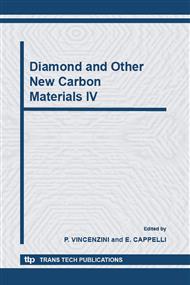p.31
p.37
p.44
p.50
p.55
p.61
p.67
p.73
p.77
Influence of Temperature on Nano-Graphene Structuring of PLD Grown Carbon Films - An X-Ray Diffraction Study
Abstract:
The physical properties of graphene nano-structures are highly anisotropic and generally correlated to the graphene sheet orientation. We investigated the capability to grow nano-graphene structured carbon films and to control their texturing by pulsed laser ablation of a pyrolytic graphite target (Nd:YAG laser, 2nd harmonic: λ=532 nm, hν=2.33 eV, τ=7 ns, ν=10 Hz, φ=7 J/cm2), operating at different temperature conditions. Carbon films were deposited on Si <100> substrates. Detailed characterisation by synchrotron X-ray measurements were performed on samples deposited in vacuum (~10-3 Pa) at high substrate temperatures (>800°C) and at room temperature followed by post-annealing at high temperature (>800°C). The X-ray measurements established the formation of nano-sized graphene structures for both sample sets. In the first set, the nano-particles are correlated among them, their size increases with substrate temperature and a longitudinal growth of parallel graphene layers occurs, with the ˆc axis parallel to the substrate. In post annealed sample set, on the contrary, the nano-particles size is smaller and depends weakly on annealing temperature. The graphene ˆc axis results to be randomly oriented up to ~850°C. Above this temperature it seems that a transition phase occurs and the c axis results to lie parallel to substrate plane.
Info:
Periodical:
Pages:
55-60
Citation:
Online since:
October 2006
Authors:
Price:
Сopyright:
© 2006 Trans Tech Publications Ltd. All Rights Reserved
Share:
Citation:


